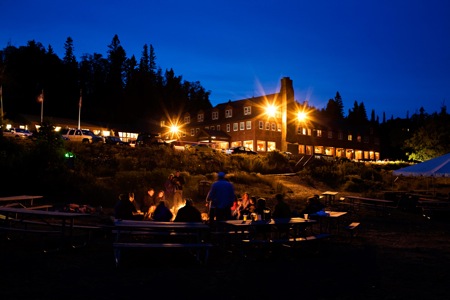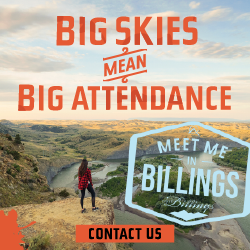
Courtesy Tim Larsen Photography
When organizations want to reflect and regroup, they do what America’s presidents have been doing for the past 50 years. They go to the woods.
Since the days of Franklin Roosevelt, America’s commanders-in-chief have retreated to Camp David, a wooded compound in Maryland’s Catoctin Mountains 60 miles from the White House.
Originally called Shangri-La, the retreat was designed as an escape from presidential stresses for an ailing Roosevelt. Every president since has used it for multiple purposes: family celebrations, powwows with heads of state, minivacations and, of course, retreats with staff.
Most companies and businesses aren’t lucky enough to have their own wooded retreat, yet there are many venues with a sense of seclusion. Like trees in the forest, these retreat sites come in many sizes and shapes. Some are reminiscent of the Spartan cabin in the woods where Henry David Thoreau spent two years; others are highbrow hideaways.
The cabins and conference center at southwest Virginia’s Hungry Mother State Park fall into the former category. The facilities aren’t fancy, but, says the park’s John Stone, coupled with the forest, mountain and lakes around them, they can inspire fanciful thoughts.
“Hungry Mother is not about the elaborate facilities, because there are no elaborate facilities,” Stone said. “Coming to Hungry Mother is kind of like going into a time warp. You leave the world of stress, of trials and tribulations and hopelessness behind, and come to a place of great serenity where you can center yourself and get balance so the world is not spinning out of control and you can remember that the Earth is a great place to be.”
Being in nature instead of the office can have its benefits. Here are several options for small retreats, from relatively rustic to ultra upscale.
Retreat centers live up to name
Retreat centers, whose primary purpose is respite and renewal, are obvious choices for business retreats. Many are aimed at religious organizations and nonprofits, but some, including the Watson Homestead Conference and Retreat Center, in Painted Post, N.Y., 12 miles from Corning, welcome corporations and other business groups.
Interestingly, the Watson Center’s roots are in business — big business. The 400-acre complex was originally the homestead of Thomas Watson, founder of IBM.
“Thomas Watson decided toward the end of his life that he wanted to dedicate his boyhood home as a center to help people and organizations develop the next generation of leaders,” said Mary Hickey, development and marketing.
Watson originally gave the property to the Methodist Church, which ran a retreat center there for a number of years. Although no longer affiliated with the church, the not-for-profit center continues to emphasize Christian values, and many church groups do gather there.
But today’s retreat center attracts groups from other sectors as well, said Hickey, anything from Boy Scouts and Rotary to government, education and corporations.
In business since 1955, the center has gotten a tad timeworn; but refurbishing is under way. “The changes we are making directly affect the comfort of guests,” said Hickey.
In addition to 27 hotel-style rooms, the Watson Center has an eight-bedroom retreat house, several retreat centers with bunkhouse-style sleeping arrangements for up to 32, and central gathering and recreation areas. Meeting spaces range from a small library to two studios below the chapel.
Much like a summer camp, the center emphasizes activity and has a team-building program. It has an Olympic-size indoor pool and backwoods trails. Sledding, cross-country skiing and campfires warm guests in the winter; summer is a time for team sports like softball and volleyball.
607-962-0541
www.watsonhomestead.com
State parks are modern, yet modest
Ohio and Virginia are among several states that have become known for their state park resorts. In wooded and often remote locations, the resorts have modern but often more modest amenities than their privately owned counterparts.
For many organizations, the state resort park’s reasonable prices are a good fit in a poor economy.
One of Ohio’s lesser known resort parks is also one of its most remote: Shawnee State Park Lodge near West Portsmouth in south central Ohio.
The lodge, in the Appalachian foothills, lies within the 63,000-acre Shawnee Forest, the largest of Ohio’s 20 state forests.
No major interstates are nearby, but U.S. Highway 23, 14 miles south, provides decent access, putting the park two hours south of Columbus and two hours east of Cincinnati.
The 50-room lodge, built in 1972, has the requisite meeting space, with as many as eight meeting rooms ranging from 480 square feet to a divisible ballroom of 3,444 square feet.
But it is the lodge’s smaller spaces that attract retreats. The 1,000-square-foot Arrowhead Room, for example, has a wall of windows and a balcony. The Scioto Room opens to a pool that overlooks Turkey Creek Lake.
The building is blessed with “all kinds of nooks and crannies” where small groups often congregate, according to Lisa Morgan, sales manager. “They just find a corner. If the weather is good, they’ll go to the porches and sit in the rocking chairs.”
Guests aren’t roughing it there. Guest rooms recently got an upgrade that included flat-screen televisions and pillow-top mattresses. The park’s 25 two-bedroom cabins are a little more rustic, but even they have cable television and screened porches, and two have hot tubs.
740-858-6621
www.shawneestateparklodge.com
Hungry Mother hidden in Blue Ridge
A career in hospitality management kept John Stone indoors for much of his work life. But a return to the workforce after retirement has put him in the middle of 2,500 acres in Virginia’s Southwest Blue Ridge Highlands, and he couldn’t be happier.
“God could not have picked up and planted me in a better location,” he said.
Hungry Mother State Park and its Hemlock Haven Conference Center, which Stone oversees, are also effective locations for retreats, said Stone. The ambiance at his park unclenches jaws and unfurrows brows, according to Stone.
“If you want someone to be productive, the first thing you have to do is relieve the stress,” said Stone. “Here, every time you blink your eyes, you see something different.”
From one of Stone’s favorite gathering places in a small dining room, visitors see “towering hemlocks on the other side of the lake that are almost 50 feet tall. Across the lake you can see a mountain, not so tall that you can’t see the top. I’ve seen people sit and stare out the window and look at the mountains for hours.”
The park — five miles from Interstate 81; an hour north of Johnson City, Tenn.; and two hours south of Roanoke, Va. — is less remote than it seems.
There are 32 cabins in all, including six built by the Civilian Conservation Corps. Most are newer, built within the past 30 years, and all have heating, air conditioning and modern baths. One modern convenience that’s missing is television, although wireless Internet access is available.
Retreat groups won’t find much availability in the summer. But the rest of the year, they can typically meet in the park’s conference center, the first in the park system.
For smaller groups, Stone prefers dining rooms in the park’s restaurant, where fires can be lit in stone fireplaces, and windows look out at the lake and mountains beyond.
Food is more than filling, due to a chef who trained at the Martha Washington Inn in nearby Abingdon, Va. “She could make sawdust taste good,” Stone said.
276-781-7425
www.dcr.virginia.gov/state_parks
Superior digs in upper Minnesota
More upscale than their state park counterparts, traditional resorts can prove equally effective as retreat locations.
Lutsen Resort, on Lake Superior, is a family-owned property 90 minutes north of Duluth, Minn., and four hours from the Twin Cities.
Over its 126 years, Lutsen has changed. Although the original lodge remains and is the heart of the resort, there are also condos, cabins and, three miles from the lodge, villas. All totaled, the resort can accommodate 700 (double occupancy).
For such a large place, the resort manages to feel small because its accommodations are situated away from one another.
“Things are positioned in a really nice way,” said Beth Hazelton, director of group sales. “We’ve had wedding groups that have said, ‘We didn’t even know other groups were here.’”
Lutsen attracts business retreats, with the exception of the summer season, when availability is limited and family vacations tend to make planning office getaways difficult, said Hazelton.
Most popular for retreats are the condos, all with lake views. Groups of 12 or fewer sometimes opt to meet in a condo living room; they can walk over to the main lodge for meals or have the resort bring in breakfast and lunch.
Some groups rent an entire condo building, which, with multiple units, can accommodate up to 18, double occupancy.
One recent retreat gave culinary team building a new turn by dividing the group of 18 into four teams and having each team cook dinner for the entire group one night.
Hazelton and her team helped out by bringing in extra tables and chairs, stemware and china so the whole group could dine together and by providing any ingredients that the group had not brought.
The resort has a meeting room and a recently remodeled lake-view boardroom, but weather cooperating, groups often sit at picnic tables on the lakeshore to strategize. In the evening, they might use the beach for a barbecue or have a bonfire.
“We make sure they have picnic tables, Adirondack chairs and wood to burn. And we’ll get the fire started for them. Some of the groups want entertainment, so we can line up a musician to play acoustic guitar.”
Sea kayak tours, fly-fishing instruction, sleigh rides, skiing and spa appointments can fill free time or keep accompanying family members entertained.
218-663-6658
www.lutsenresort.com
Small groups can “own” small inns
Being able to own the place is a distinct possibility when small groups choose an inn for a retreat.
Many small inns in the United States consider meetings part of their business; others are just beginning to try their hand at the business. Milliken Creek Inn and Spa, near Napa, Calif., for example, has gained a reputation for its 12 romantic and large guest rooms, its luxury spa and its private spot along the slow Napa River.
But manager Connie Gore has realized that other than the busy fall season, when tourists flock to Napa for the grape harvest, her inn is a good choice for businesses on retreat.
“We don’t really have your traditional boardroom experience,” she said. “I tell groups, you have to think outside the box here.”
That sort of thinking can lead to meetings on roomy decks or patios with a yoga session on the lawn or a kayak paddle down the river to break up the business. For one of her own meetings, Gore gathered attendees in the inn’s spa.
At mealtime, groups can hop in the car for a short drive into Napa or other wine country towns.
And like all guests, groups get to enjoy what the inn calls its “magic hour,” a daily, complimentary happy hour that features tapas and other treats accompanied by local wines poured by the vintners who make them.
Maryland inn worth the trip
One inn purpose-built for retreats is Savage River Lodge, near Frostburg, Md., less than three hours from Washington, Pittsburgh and Baltimore and five miles from Interstate 68.
Built of fir and spruce, the lodge sits on 45 acres within the 750-acre Savage River State Forest surrounded by 18 one-bedroom cabins. Since the first guests checked in about a decade ago, the lodge has been recognized by Wine Spectator, Condé Nast Johansens and others. It recently became a member of Select Registry, a group of 400 high-end inns.
Although the lodge is a little more than five miles from a major interstate — 1.5 miles of that private gravel road — it seems more removed. “Once you are in here, it is like another world,” said Carol Dicenso, guest services manager. “We make jokes and call it Lodge Land.”
It is not unusual for a business retreat — government, military and private industry among them — to book the entire lodge, and a number of groups come back year after year.
Availability for buyouts varies with the time of year. Fall is heavily booked with leisure business because of the colorful foliage.
Winter months are a “wonderful time for retreats,” said Dicenso, as long as groups remember that they might need to rent a four-wheel drive vehicle to get there. With notice the lodge will shuttle people in and out in its four-wheel vehicle.
Spring offers the most flexibility, although the weather can be wet and gray.
The conference room upstairs in the lodge is its own enclave, with restrooms, a prefunction area, a library for breakouts, and a deck for outdoor meals or breaths of fresh air. It seats 34.
Each of the 18 cabins has a bedroom and a living area with a sleeper sofa, if attendees don’t mind sharing a bath.
Activities are appropriately woodsy, with hiking, birding and stargazing among them. In the winter, tramps through the snow on cross-country skis or snowshoes can be exhilarating and send guests rushing back to the lodge’s fine-dining restaurant, which is also open to the public.
301-689-3200
www.savageriverlodge.com











